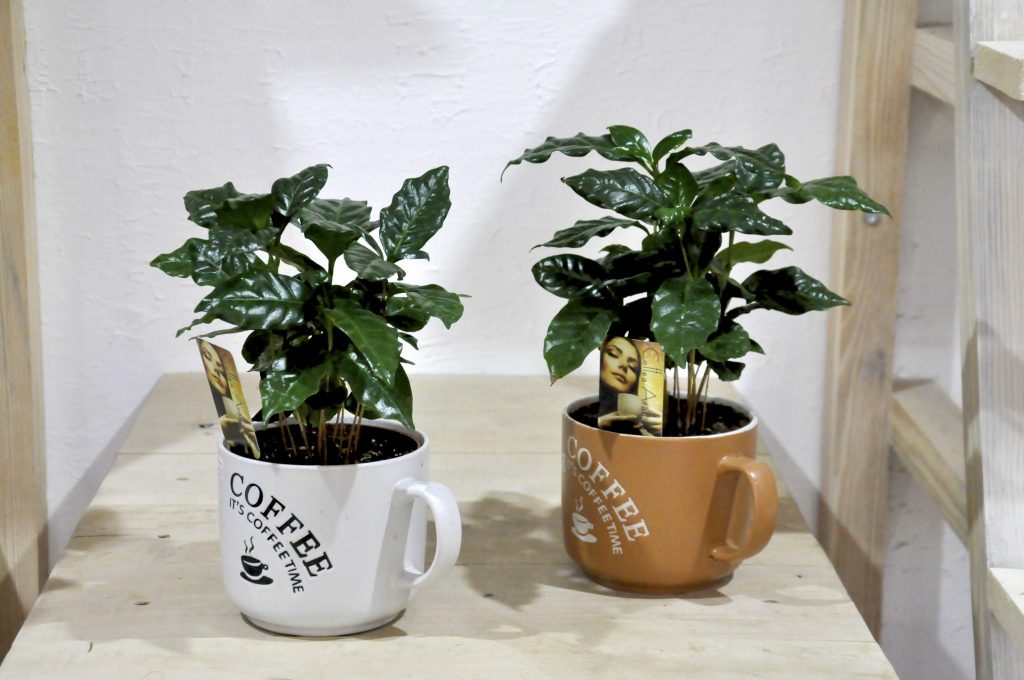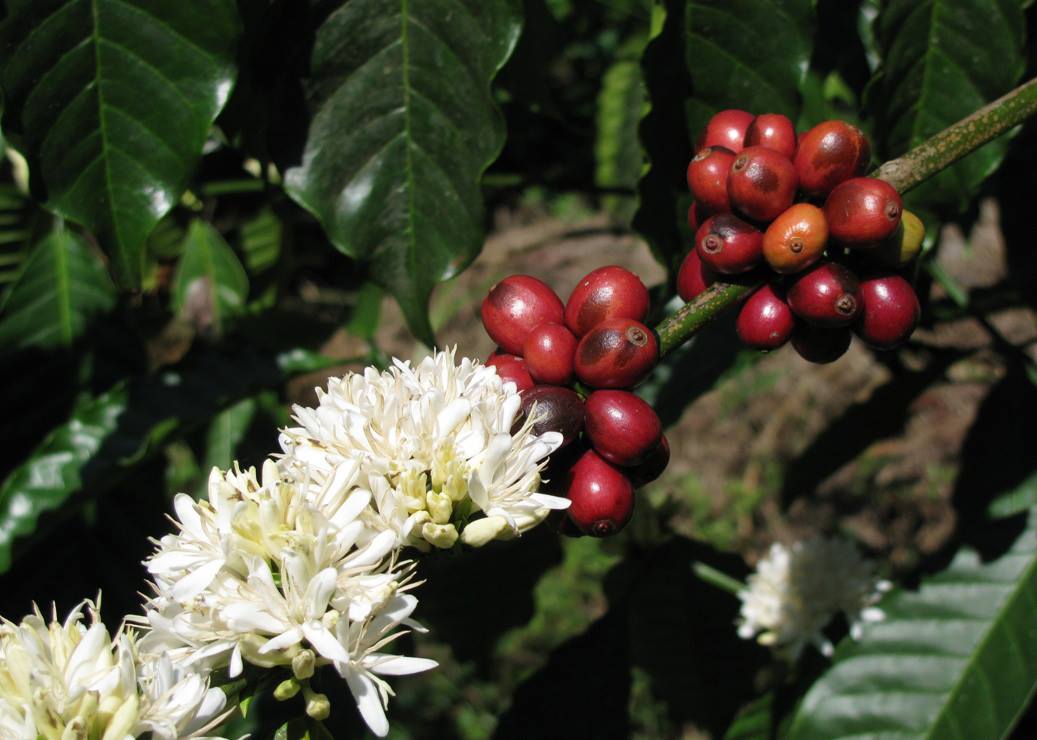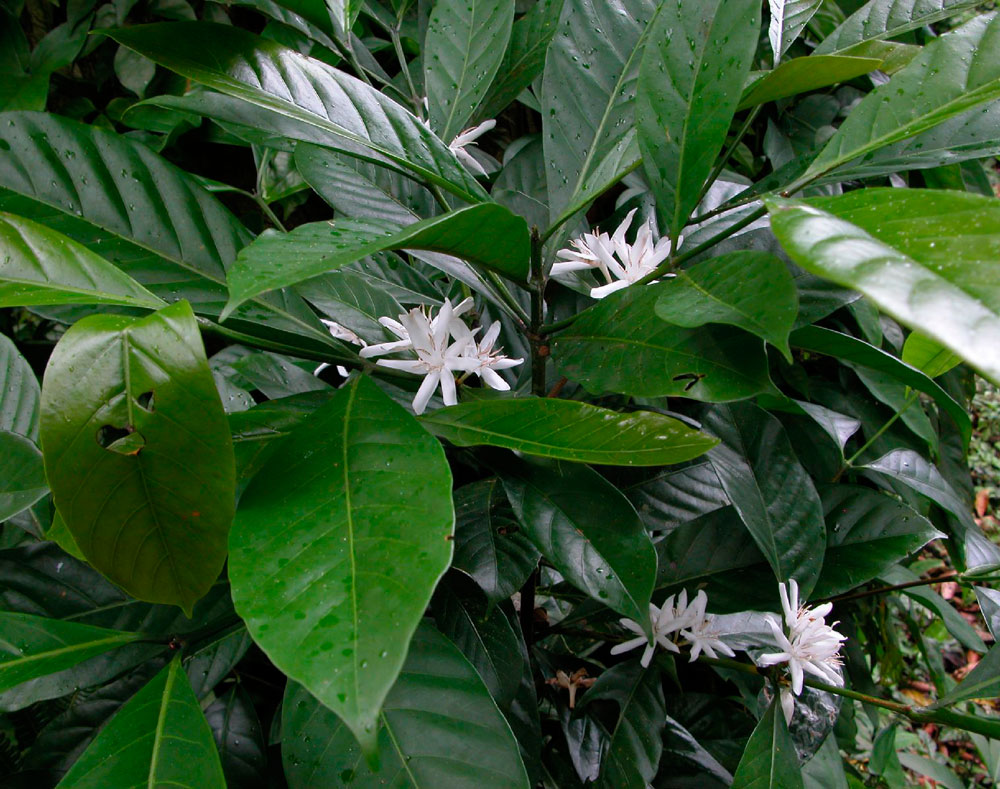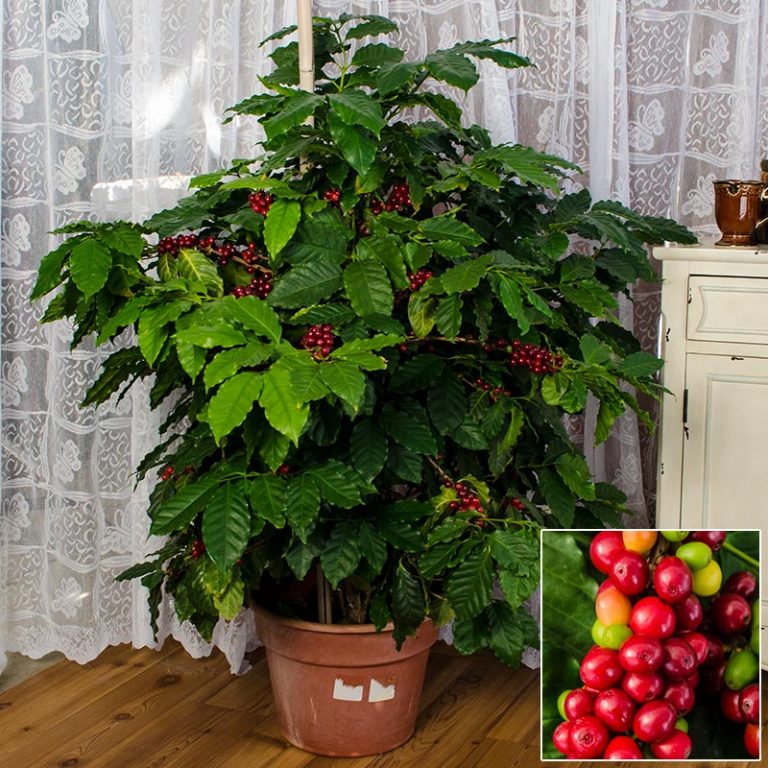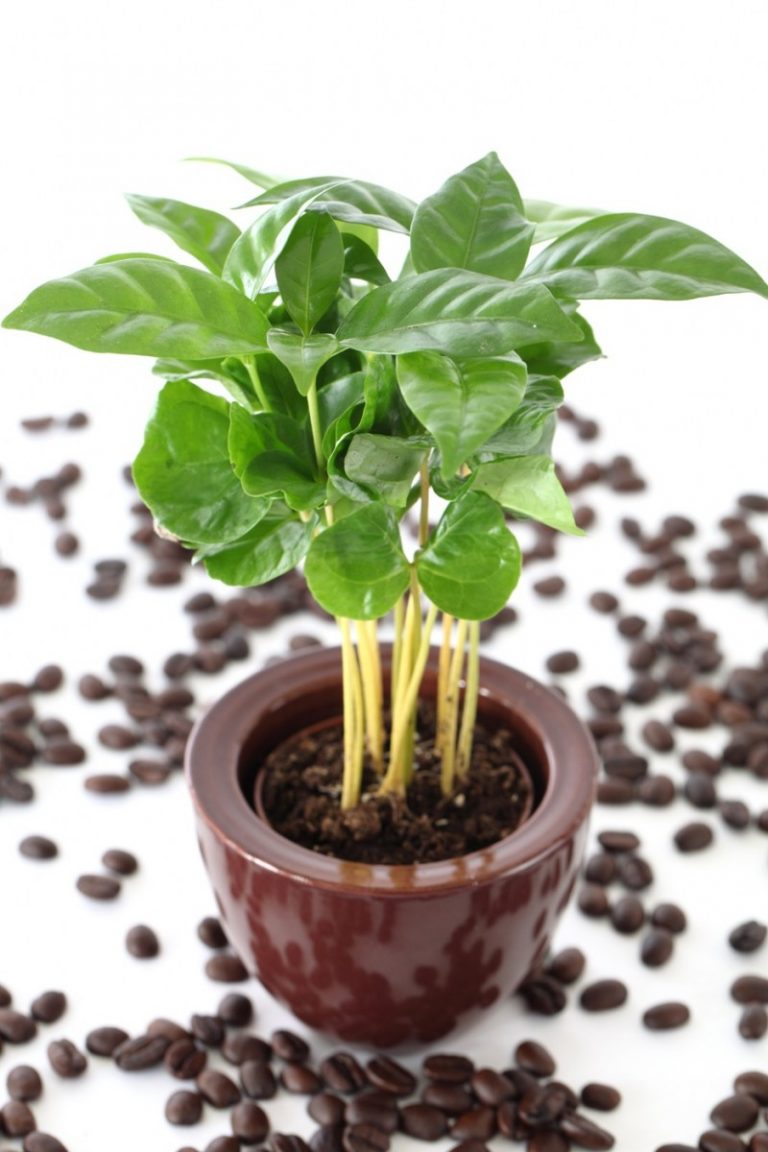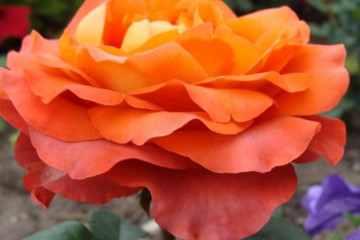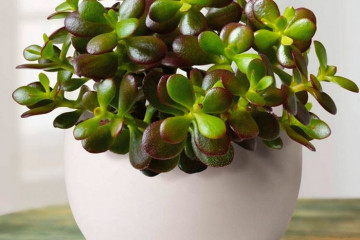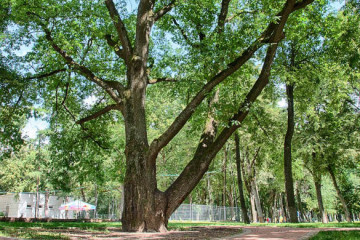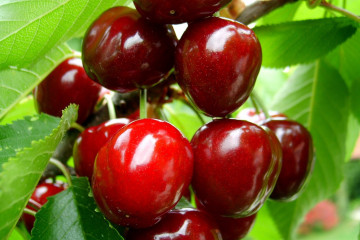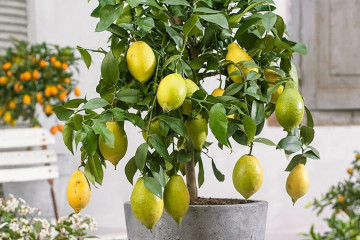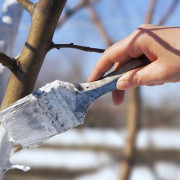Indoor trees: caring for the Arabica coffee plant at home
Content:
Increasingly, Arabica coffee - a houseplant decorates the interior of the apartment. Some growers believe that an experienced florist can grow an exotic. If houseplant Arabica coffee is bred, care is not complete without features. The tree will delight you with the first harvest several years after planting, it will not hurt to be patient.
Description of home coffee flower
Coffea Arabica is a coffee tree or perennial shrub that belongs to the Madder family. The plant grows on the Asian and African continents, they are widely engaged in the cultivation of coffee at home.
The height of the culture reaches 1.5 m. The tree has a dense luxurious crown, foliage of intense green color, elongated. The arrangement of coffee leaves is opposite on elastic, slightly branched stems. The leaf plate is glossy, with obvious veins. The roots of the Arabian plant are branched. The central root is elongated.
Fruits and flowers have an extraordinary decorative effect. The flowers of the tree resemble jasmine-like stars with white petals and an attractive scent. They are collected in brushes of 3-6 pcs. Dissolution of buds occurs in the spring. Coffee fades quickly, after 1 or 2 days.
After 6 months, fruits are formed in place of the inflorescences, which look like elongated reddish cherries. When ripe, they darken, acquiring a black tint. There are 2 coffee beans in the cherry.
Varieties of coffee trees
Arabica
Rocky hills, volcanic plateaus, highlands are preferred for the Arabian coffee tree. Up to 5 kg of grains per year are removed from an adult, which is approximately 1 kg of fruit. Home plant coffee feels great in a container: they form a tree up to 1.5 m in height or grow up with a bush.
Creation of comfort and competent care will ensure that 500 g of fruits from an adult culture are obtained. The coffee harvest is not the largest, but this is not the main purpose of the Arabica plant.
Popular among gardeners Albert is a dwarf variety that is grown indoors. The elegant plant is an evergreen tree that reaches a height of 3-5 m.If they do not violate the rules of maintenance, it blooms twice annually, in spring and summer.
Robusta
An unassuming tree was discovered in the Congo Basin in the 18th century. Distinctive features of culture:
- withstands temperature drops;
- grows on depleted soil;
- brings a bountiful harvest.
However, Robusta became widespread after the destruction of Arabica stocks in Sri Lanka by leaf rust in the 2nd half of the 19th century. The appearance of the robust plantation dates back to 1900 and is associated with the island of Java.
Robustus is translated from Latin as wild, strong, strong. It is considered the best natural energy drink, but inferior to Arabica in taste.
The coffee tree is not tall, resembles a shrub 2-3 m high. The pubescent leaves are rich green, with veins. Fragrant coffee flowers have a white color.
The ripening of the grains takes place over 9-11 months, a five-meter tree gives 1.5 kg of a fragrant crop per season.
Liberica
If choosing coffee at home, growing Liberica is a good option. Ripe fruits differ in appearance: scarlet or orange-sun shade. The foliage is 40 cm long. Pruning helps in height adjustment and crown formation.
The inflorescences have a white color, the yellowish-reddish fruits have a large seed.
Excelsa
Excelsa has been considered since 2006 as a species of Liberica. In the wild, the tree grows up to 20 m. On plantations, trees are pruned to 1.5 m for the convenience of coffee pickers.
Wide sheets of Excels have smooth edges. They are slightly thinner than Liberica, but rougher than Robusta. The large flowers of the plant have a spicy aroma.
The positive characteristics of a demanding tree include low susceptibility to pests and diseases.
The plant is often used as a graft for other varieties to increase its vitality.
Growing a coffee seedling
What is needed for landing
A coffee tree is grown in a special soil. They buy it in a store or prepare it yourself. The following components will be needed:
- sheet soil;
- peat;
- river sand;
- rotted manure.
Charcoal is mixed with grated moss. The pH of the substrate is 5.0-5.5. When spraying, it is possible to add a couple of droplets of vinegar to the water.
A young culture will have to be transplanted next year, an adult in 3 years. Next, the top soil layer is changed. The composition of the soil should be sour, fertile, rather light. It is responsible for aerating the root system and preventing water stagnation.
Optimal location
Ideal for positioning coffee tree windows on the west and east side of the house. In the summer season, the culture is taken out on the balcony, which is protected from wind and rain, as well as the burning sun.
Frequent changes in the environment, which negatively affect fruiting, are not encouraged. If you want to get grains, the tree is not touched. Giving symmetry to the crown of coffee provokes crop loss.
When the plans are to rearrange the flower to another window sill, where there is more light, the following measures are taken:
- The bush is wrapped with gauze.
- The shelter is left for 2-4 weeks so that the culture gets used to the new environment and lighting.
- No burns after removing the gauze cover indicates approval of the new location.
Coffee is one of the plants that prefer solitude and dislike the crops in the neighborhood. A separate window sill fits the seedling.
Pot selection
The selection of the pot is determined by the central root of the coffee tree. The size of the container is at least 30% larger than the seedling for the plant to obtain useful elements in sufficient volume.
To prevent moisture from stagnating, good drainage is required. Expanded clay or broken brick is placed at the bottom of the vessel.
When a plant is transplanted, the main thing is not to disturb the roots, to reload the coma, add soil to the sides and on top, and compact it slightly.
Breeding coffee
Cuttings
Cuttings are used for breeding coffee. Distinctive features of the method:
- 10-15 cm cuttings are cut obliquely from an adult culture;
- there are 2 internodes on the workpiece;
- the distance to the lower flower bud is 2 cm;
- the sheets on the harvested material are halved to avoid moisture loss.
For the shoots, you will need a nutritious soil mixture, which includes peat and granular river sand. It is useful to ignite the mixture in the oven to eliminate harmful microorganisms. Each cutting is deepened into the soil by 1-1.5 cm, the earth is tamped a little, watered and covered with a plastic bottle to create greenhouse conditions. The temperature regime in such a greenhouse is + 25… + 27ºC.
A mini greenhouse needs regular ventilation and humidification. The plant's root system takes 4 to 5 weeks to form. The appearance of new shoots in the culture speaks of the rooting of the seedling. When 3-4 leaves develop, the coffee is transplanted into a container with a standard soil mixture.
From the bone
Coffee is grown using beans that are removed from a fruitful tree or ordered over the Internet. The fruits from the tree are characterized by high germination. The shelf life of seeds is limited to one year.
The dense shell of the seeds makes germination difficult. To accelerate the appearance of sprouts, use a step-by-step guide:
- place the seed for 24 hours in a weak vinegar solution;
- cut the skin along the length with a sharp knife;
- knock on the grain with a hammer to crack the peel.
After manipulations, the seeds are placed in a biostimulator using Heteroauxin, Kornevin, Ribav-Extra, Ukorenit.
They are planted in a small bowl, which is filled with a nutritious substrate. The grains are buried with the flat side by 1.5 cm. The soil is moistened and covered with film or glass.
The container with seedlings is placed in a bright place where direct sunlight does not fall. Maintain soil mixture moistening and temperature regime of +25 ° С. Remember to air every day. If the conditions are met, sprouts are expected to hatch after a month.
The formation of the first pair of leaves indicates the need for transplantation. The pick is carried out in small but deep flowerpots, the diameter of which is 7 cm. The composition of the soil is similar. With the development and strengthening of the root system, the plants are transferred to new pots after 10 months.
Caring for an adult coffee tree
Watering mode
When growing houseplant Arabica coffee, care includes correct watering. The plant is picky about moisture during flowering and fruiting:
- It is forbidden to water the seedling with tap water. It is necessary that it stand for 2 days.
- Culture doesn't like lime.
- Moistening of the substrate in the container is carried out with a liquid at room temperature or higher by 2-3 ° C at any time of the year.
- The residues from the pallet are certainly removed after watering.
Indoors, a coffee tree will love it if it is sprayed daily with lukewarm water.
In winter, the culture will not need the procedure. In case of strong dust, wipe the leaves with a damp sponge.
Top dressing
Mineral feed has a beneficial effect on the plant. They are brought in with the arrival of spring and continue until fruiting is complete. They are fed twice a month with mineral fertilizers. Top dressing is carried out by dissolving nitrate (5 g) and potassium salt (3 g) in 1 liter of water. Single dose for adult culture - liter jar. Possible arrangement of mineral fertilizers with organic matter (manure).
Timeliness of feeds is a stimulator of tree growth and increasing bushiness. You will need constant pinching of the side shoots.
Preparing for winter
If a flower is being prepared for winter, the caring procedures include:
- The location of the coffee tree is on the south side. The minimum room temperature is + 15 ° C.
- The use of fluorescent lamps on cloudy and cold days.
- Reducing watering in winter.
- Stop feeding from October to March.
If the plant is properly looked after, after a few years, the homemade Arabica will thank the hostess with aromatic fruits and allow you to feel the taste of real coffee.
